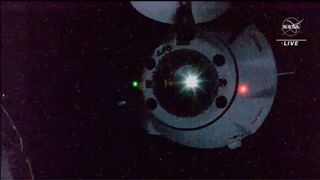
(Image credit: NASA TV)
A robotic SpaceX Dragon cargo capsule is returning to Earth today (April 15) after a month parked at the International Space Station.
The Dragon CRS-27 supply ship undocked from the International Space Station at 11:05 a.m. EDT (1505 GMT) as both spacecraft orbited high over the Indian Ocean, beginning an hours-long trip back to its home planet. It was expected to splashdown on Earth about six hours after undocking, SpaceX wrote in a Twitter update (opens in new tab).
“After re-entering Earth’s atmosphere, the spacecraft will make a parachute-assisted splashdown off the coast of Florida on Saturday, April 15,” NASA wrote in blog post (opens in new tab). NASA will not livestream the Dragon capsule’s splashdown.
Related: Facts about SpaceX’s Dragon capsule
The Dragon launched into orbit from Florida’s Cape Canaveral Space Force Station on March 14, kicking off SpaceX‘s 27th robotic cargo run to the orbiting lab for NASA.
The Dragon carried up about 6,300 pounds (2,860 kilograms) of supplies on its mission, which is known as CRS-27. (CRS stands for “commercial resupply services.”) The cargo included a variety of hardware, 60 different scientific experiments and some gustatory treats for the station astronauts.
“The crews requested some fresh fruit and refrigerated cheeses,” Phil Dempsey, NASA’s International Space Station Program transportation integration manager, said during a CRS-27 prelaunch press conference on March 13. “So on board are apples, blueberries, grapefruit, oranges [and] cherry tomatoes, as well as a few different cheeses.”
The CRS-27 Dragon will carry about 4,300 pounds (1,950 kg) of “experiment hardware and research samples” down to Earth with it today, according to the NASA blog post.
This is a unique capability of the SpaceX capsule. The other two robotic cargo craft that currently service the space station — Russia’s Progress vehicle and Northop Grumman’s Cygnus — are designed to burn up in Earth’s atmosphere when their time in orbit is up.
Editor’s note: This story was updated at 1:45 pm ET to reflect the successful undocking of the Dragon CRS-27 spacecraft.
Mike Wall is the author of “Out There (opens in new tab)” (Grand Central Publishing, 2018; illustrated by Karl Tate), a book about the search for alien life. Follow him on Twitter @michaeldwall (opens in new tab). Follow us on Twitter @Spacedotcom (opens in new tab) or on Facebook (opens in new tab).
Join our Space Forums to keep talking space on the latest missions, night sky and more! And if you have a news tip, correction or comment, let us know at: community@space.com.






